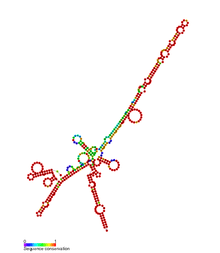RevCen
| RevCen | |
|---|---|
 | |
| Conserved secondary structure of RevCen RNA. | |
| Identifiers | |
| Symbol | RevCen |
| Other data | |
| RNA type | Gene; pre-miRNA |
| Domain(s) | Schizosaccharomyces |
RevCen is a family of non-coding RNA found in Schizosaccharomyces. It is a megastructure containing several siRNA which use the RNAi pathway to regulate heterochromatin formation. The long RNA transcript forms a secondary structure with several stem-loops which are processed by dicer into siRNA. This siRNA then initiate the formation of heterochromatin at the centromeres of fission yeast.[1] Northern blot analysis confirmed the siRNAs were produced from the large RNA structure RevCen in vivo. As with all siRNAs, the enzyme dicer is responsible for dissecting dsRNA into the 21nt stretch of double-stranded RNA. Human recombinant dicer enzyme processed the RevCen structure in vitro, though the same activity by yeast Dcr1 has not been confirmed.[1]
This is a different mechanism to that involving the well-understood RITS (RNA-induced initiation of transcriptional gene silencing) complex.[2][3] It has been suggested that both mechanisms work together, with the RevCen structure potentially acting as a backup system when Rdp1-generated double-stranded siRNA precursors are lost.[1]
References
- 1 2 3 Djupedal I, Kos-Braun IC, Mosher RA, et al. (December 2009). "Analysis of small RNA in fission yeast; centromeric siRNAs are potentially generated through a structured RNA". EMBO J. 28 (24): 3832–44. doi:10.1038/emboj.2009.351. PMC 2797062
 . PMID 19942857.
. PMID 19942857. - ↑ Sugiyama T, Cam H, Verdel A, Moazed D, Grewal SI (January 2005). "RNA-dependent RNA polymerase is an essential component of a self-enforcing loop coupling heterochromatin assembly to siRNA production". Proc. Natl. Acad. Sci. U.S.A. 102 (1): 152–7. doi:10.1073/pnas.0407641102. PMC 544066
 . PMID 15615848. Retrieved 2010-08-17.
. PMID 15615848. Retrieved 2010-08-17. - ↑ Verdel A, Jia S, Gerber S, et al. (January 2004). "RNAi-mediated targeting of heterochromatin by the RITS complex". Science. 303 (5658): 672–6. doi:10.1126/science.1093686. PMC 3244756
 . PMID 14704433. Retrieved 2010-08-17.
. PMID 14704433. Retrieved 2010-08-17.
Further reading
- Vavasseur; et al. (2008). "Heterochromatin Assembly and Transcriptional Gene Silencing under the Control of Nuclear RNAi: Lessons from Fission Yeast". RNA and the Regulation of Gene Expression: A Hidden Layer of Complexity. Caister Academic Press. ISBN 978-1-904455-25-7.
- Sigova A, Rhind N, Zamore PD (October 2004). "A single Argonaute protein mediates both transcriptional and posttranscriptional silencing in Schizosaccharomyces pombe". Genes Dev. 18 (19): 2359–67. doi:10.1101/gad.1218004. PMC 522986
 . PMID 15371329. Retrieved 2010-08-17.
. PMID 15371329. Retrieved 2010-08-17. - Steiner NC, Hahnenberger KM, Clarke L (August 1993). "Centromeres of the fission yeast Schizosaccharomyces pombe are highly variable genetic loci". Mol. Cell. Biol. 13 (8): 4578–87. PMC 360078
 . PMID 8336703. Retrieved 2010-08-17.
. PMID 8336703. Retrieved 2010-08-17. - Takahashi K, Murakami S, Chikashige Y, Niwa O, Yanagida M (March 1991). "A large number of tRNA genes are symmetrically located in fission yeast centromeres". J. Mol. Biol. 218 (1): 13–7. doi:10.1016/0022-2836(91)90867-6. PMID 2002498. Retrieved 2010-08-17.
